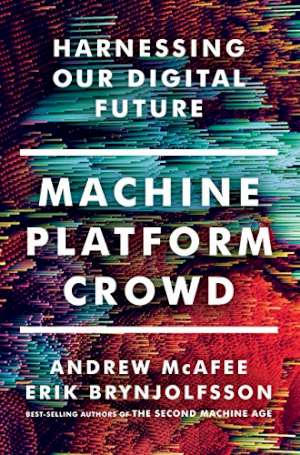05 December 2017
Machine, Platform, Crowd
Harnessing Our Digital Future
Andrew McAfee and Erik Brynjolfsson
2017, W W Norton and Company, 416 pages,
ISBN 9780393356069
Reviewer: Ian Bright

This book is both useful and annoying. Its usefulness comes in providing an overview of three developments in technology that are changing the way people and businesses interact. The annoyance comes from underplaying the challenges associated with these developments.
The three developments in technology form the book’s title. Machine learning is now well advanced and many decisions are made better by machines using data and mathematics than by people whose cognitive biases allow misjudgement. Platform approaches to markets are improving the matching of buyers and sellers. Crowd sourcing information provides a wider variety of insight and responses, allowing problems or regular tasks to be solved or completed more quickly and at lower costs.
The authors make a persuasive case that these technologies are revolutionary rather than evolutionary. They refer to the reasonably well-known example of the way electricity revolutionised factory production. Electrification allowed individual machines to have individual small electric motors, allowing greater flexibility in factory design compared with steam powered factories where machines were grouped together in large factories. But many companies resisted this change. They failed. Those which experimented and redesigned their operations succeeded. McAfee and Brynjolfsson argue the combination of the three technologies will require a total redesign of production and markets. The book lists many examples of this happening at the moment and individual companies experimenting with the best way to organise production.
This listing of corporate success stories threatens turning the book into mere boosterism for new technologies. Two chapters save the book from this. Chapter nine looks critically at the determinants of supply and demand that affect pricing in a platform economy. Chapter thirteen draws on research in transaction cost economics and incomplete contracts to explain why and how companies will continue to exist in the future despite the atomisation and personalisation possible through digital technology. If pressed for time, read chapters one, nine and thirteen carefully. The rest of the book can then be covered quickly.
Annoyingly, the book lists many individual companies that are using the technologies and implicitly uses them as examples of the inevitable success of the digital revolution. Little attention is paid to their profitability; indeed it is simply stated that they are likely to be profitable in the future. There is no guarantee of this of course. Listing the successful in this way can be interpreted as falling for survivorship bias. Equally, the discussion underplays the way in which many tech industries are developing dominant players. Returns to scale appear to be large.
The authors do try to guard against over-optimism by writing in the first chapter that, “This book is a guide to the world being created by the new machines, platforms and crowds. It is by necessity an incomplete work … So we would never claim to have discovered the final and complete answers to business success as our economies and societies.” It is undeniable that technology is changing business and society. Nobody can be confident what can happen. The authors recognise this but their recognition of the risk of overt optimism at the beginning is at risk of being lost by the end.
